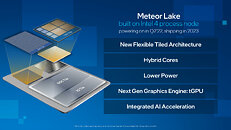- Joined
- Oct 9, 2007
- Messages
- 47,598 (7.45/day)
- Location
- Dublin, Ireland
| System Name | RBMK-1000 |
|---|---|
| Processor | AMD Ryzen 7 5700G |
| Motherboard | Gigabyte B550 AORUS Elite V2 |
| Cooling | DeepCool Gammax L240 V2 |
| Memory | 2x 16GB DDR4-3200 |
| Video Card(s) | Galax RTX 4070 Ti EX |
| Storage | Samsung 990 1TB |
| Display(s) | BenQ 1440p 60 Hz 27-inch |
| Case | Corsair Carbide 100R |
| Audio Device(s) | ASUS SupremeFX S1220A |
| Power Supply | Cooler Master MWE Gold 650W |
| Mouse | ASUS ROG Strix Impact |
| Keyboard | Gamdias Hermes E2 |
| Software | Windows 11 Pro |
Intel's next-generation Core "Meteor Lake" processor is now ramping for mass-production, with product launches expected in the second half of 2023, the company announced in its Q1-2023 Financial Results release. "Meteor Lake" will see Intel debut its next-generation foundry node, the Intel 4. The company is expected to use this node for the Compute Tile of the "Meteor Lake" processor, the piece of silicon that has the CPU cores. Intel 4 is said to offer transistor-density and performance/Watt comparable to TSMC's N5-series and N4-series foundry nodes. In the same release, Intel stated that development of its future foundry nodes, Intel 3, Intel 20A, and Intel 18A, are on track. In its top configuration, "Meteor Lake" is expected to feature a CPU core configuration of 6P+16E, and we are hearing that it will see a more limited release in the desktop segment, in that the processor will only come in Core i3 and Core i5 brand extensions, not Core i7 or Core i9 (which would be taken up by "Arrow Lake," with its higher P-core count). "Meteor Lake" will span a variety of mobile segments from 7 W ultraportables, to 45 W mainstream notebooks, and possibly even 55 W gaming notebooks.

View at TechPowerUp Main Site

View at TechPowerUp Main Site










